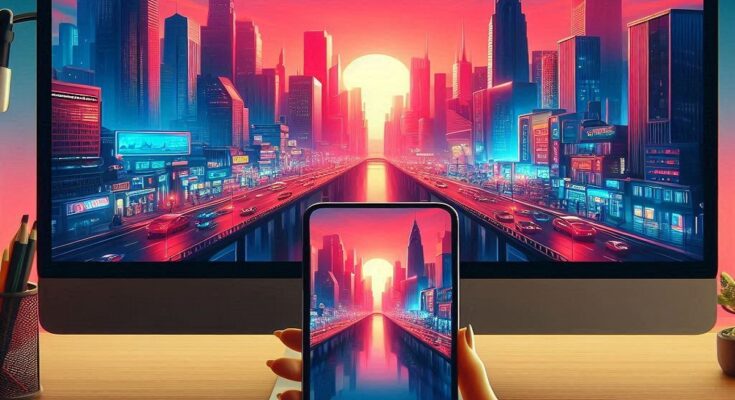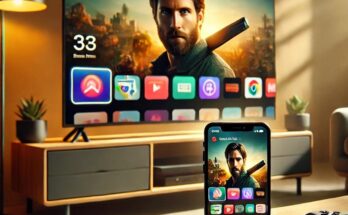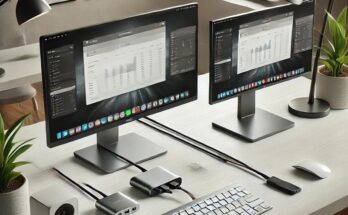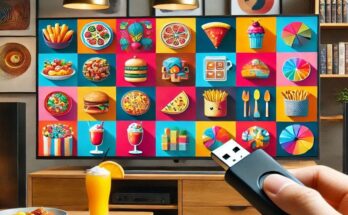The desire to leverage the convenience of your phone’s portability with the expansive screen real estate of your PC is a common one. Thankfully, technology offers a couple of reliable methods to mirror your phone’s screen onto your PC, unlocking a world of possibilities. Whether you want to share vacation photos with loved ones, showcase a captivating mobile game to your audience, or deliver a presentation using your phone’s content, mirroring your phone on your PC proves to be a valuable tool. Here, we’ll delve into the two main methods for achieving this feat: the wireless wonder, AirPlay, and the wired warrior, the USB connection.
Method 1: AirPlay – Unleashing the Wireless Potential
If you own Apple devices, AirPlay might be your answer. This native Apple technology allows you to mirror your iPhone or iPad screen wirelessly to compatible devices, including your PC. Here’s what you’ll need to get started:
Pre-requisites:
- AirPlay Compatibility: Ensure your PC has AirPlay receiving capabilities. This feature is typically available on Windows PCs with the iTunes app installed or through dedicated AirPlay receiver software. Some newer Windows laptops might also have built-in AirPlay support.
- Wi-Fi Connection: Both your phone and PC need to be connected to the same Wi-Fi network for AirPlay to work its magic.
Setting Up AirPlay on Your PC (Using iTunes):
- Open the iTunes app on your PC.
- Click on the AirPlay icon located at the top right corner of the iTunes window (it resembles a rectangle with an upward triangle).
- Choose your PC: A list of available AirPlay devices will appear. Select the name corresponding to your PC.
Initiating Screen Mirroring on Your iPhone:
- Swipe down from the top-right corner (iPhone X and later) or swipe up from the bottom (iPhone 8 and earlier) to open the Control Center.
- Locate the Screen Mirroring icon (two overlapping rectangles).
- Tap on Screen Mirroring.
- Select Your PC: A list of available AirPlay devices will appear. Choose the name corresponding to your PC.
- Enter the Code (if prompted): Sometimes, a security code will appear on your PC screen. Enter this code on your iPhone to complete the connection.
Congratulations! Your iPhone screen should now be mirrored onto your PC window within iTunes. You can now interact with your iPhone apps and navigate its screen using your PC’s mouse and keyboard (limited functionality available).
Troubleshooting AirPlay:
- Network Blues: Double-check that both devices are connected to the same Wi-Fi network. Consider restarting your router and PC if connectivity issues persist.
- Software Updates: Ensure your iPhone and PC software are updated to the latest versions. Outdated software can sometimes hinder AirPlay functionality.
- Firewall Restrictions: In rare cases, firewall settings on your Wi-Fi network might block AirPlay. Consult your router’s manual or internet service provider for assistance in adjusting firewall settings.
Method 2: USB Connection – The Wired Powerhouse
For those who prefer a wired connection or lack AirPlay compatibility, utilizing a USB cable offers a reliable solution. Here’s what you’ll need:
- USB Cable: A cable compatible with your phone (Lightning for iPhones, USB-C for most Android phones).
- Mirroring App (Optional): While some phone manufacturers offer built-in screen mirroring functionality via USB, some might require you to download a third-party mirroring app from the app store. Explore your phone’s settings or consult your phone’s user manual for specific instructions.
Connecting with a USB Cable:
- Connect the USB Cable: Plug one end of the USB cable into your phone’s charging port and the other end into an available USB port on your PC.
- Trust This Device (if prompted): Your phone might prompt you to confirm trusting the connected device. Grant permission for data transfer.
- Mirroring App Launch (if applicable): If using a third-party mirroring app, launch the app on your phone after connecting the USB cable. The app might provide additional setup instructions.
Activating Screen Mirroring on Your Phone:
The specific steps to activate screen mirroring on your phone might vary depending on the phone model and operating system. Here’s a general guideline:
- Android Phones: Look for options like “USB Tethering” or “Cast” within your phone’s settings menu. Selecting these options might prompt you to choose the type of device you’re connecting to Select “PC” or a similar option to initiate screen mirroring. Some phone manufacturers might offer a dedicated “Screen Mirroring” option within the settings menu.
Samsung Phones (Specific Instructions):
Samsung phones often have a built-in screen mirroring feature called “Smart View.” Here’s how to activate it:
- Swipe down from the top of your screen to open the notification panel.
- Swipe down again to expand the notification panel.
- Locate the “Smart View” icon (it resembles a rectangle with a play button inside).
- Tap on “Smart View.” Your phone will search for available devices.
- Select Your PC: Choose the name corresponding to your PC from the list of detected devices.
Congratulations! Your Android phone’s screen should now be displayed on your PC. You can interact with your phone’s apps and navigate its screen using your PC’s mouse and keyboard (limited functionality available).
Optimizing the Mirrored Experience:
Here are some tips to enhance your phone mirroring experience on PC:
- Screen Resolution: Adjust the screen resolution on your PC to match your phone’s resolution for optimal viewing. You can usually access these settings through your PC’s display settings.
- Orientation Lock: Activate orientation lock on your phone to prevent the screen from rotating based on its physical position. This ensures a stable viewing experience on your PC.
- Performance: Running resource-intensive apps on your phone while mirroring can strain your PC’s performance. Consider closing unnecessary background applications on your PC for a smoother experience.
The Choice is Yours!
Both AirPlay and the USB connection offer effective ways to display your phone screen on your PC. AirPlay provides a convenient wireless solution, while the USB cable offers a reliable wired option. Consider your needs and preferences when choosing the method that best suits you.
Beyond the Basics: Additional Considerations
Here are some additional points to keep in mind:
- Third-Party Apps: While some phone manufacturers offer built-in mirroring functionality, you might need to explore third-party mirroring apps for specific phone models. Research reputable apps with good user reviews before downloading.
- Software Compatibility: Ensure compatibility between your phone’s operating system and the mirroring software (if using a third-party app) on your PC.
- Latency: There might be a slight delay between your phone’s actions and what appears on your PC screen, especially with wireless connections. This is typically minimal and shouldn’t significantly impact most use cases.
By following these steps and exploring the available options, you can effortlessly bridge the gap between your phone and PC, unlocking a world of possibilities for productivity, entertainment, and sharing experiences on the big screen. So, get ready to mirror and enjoy!




